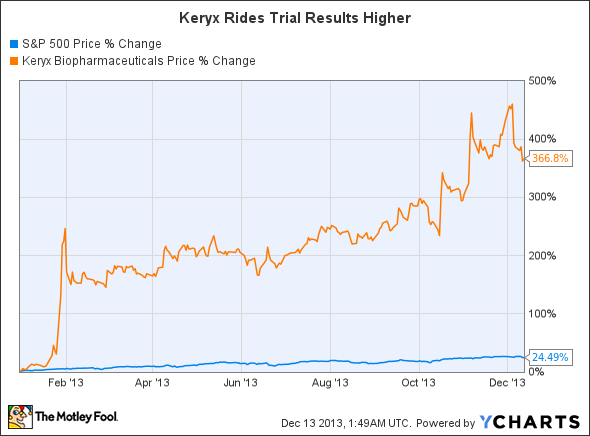Developmental pharmaceutical companies can bring plenty of joy or sorrow to investors. Keryx Biopharmaceuticals (KERX) has a history of both. Shares eroded over 70% in April 2012 after the massive failure of the colon cancer drug candidate perifosine. That single binary event, now a distant thought, proved why investing in young companies is so risky. The explosion of shares on great data for its chronic kidney disease, or CKD, drug Zerenex in the beginning of 2013 has proven why it can be so very rewarding.
Keryx has no other compounds on the market or in development, which makes this year's driving force quite obvious. A New Drug Application, or NDA, for Zerenex has been submitted and accepted by the United States Food and Drug Administration. Approval for the drug, which seems very likely, should lead to increased competition for less-encompassing phosphate binders, such as Renvela from Sanofi (SNY -1.24%) and Phoslo from Fresenius (FMS -1.29%). Let's review the reasons why, and reflect on progress made in 2013.
Positive results go boom!
In late January, Keryx announced that Zerenex had met its primary endpoint, and all key secondary endpoints in a phase 3 trial for treatment of elevated serum phosphorus levels in patients with end-stage renal disease on dialysis. That mouthful of words means that the drug kept patients' levels of phosphorus, which typically increase without proper kidney function, within a normal range compared to placebo. Nailing your primary endpoint is important, but Renvela and Phoslo work in similar fashion. There's also a cheaper generic version of Renvela coming to market in 2014.
So why would doctors want to prescribe Zerenex over the competition? The drug met secondary endpoints that compared it to Renvela and Phoslo (the active controls) in boosting iron storage. Patients taking the two incumbents usually require intravenous iron to stay within healthy ranges, and managed a negligible 1.5% improvement in the 52-week study. Excitingly, Zerenex boosted iron levels by an average of 50.8% in 249 patients during the same time period. That key advantage has analysts and investors sporting wide grins; but the opportunity doesn't end there
Keryx isn't done
The estimated annual sales opportunity for treating dialysis-dependent CKD is about $300 million. However, phase 2 results announced in November show promise in treating elevated phosphorus levels and iron deficiency for non-dialysis dependent CKD patients, too. That could peg the annual sales opportunity for Zerenex near $1 billion. Not bad for a company that began the year with just $10.5 million in shareholder equity.
Foolish bottom line
Once left for dead, this developmental pharmaceutical company has clawed its way back in 2013. Next year should be punctuated by continuing development of secondary applications and key regulatory decisions. The FDA has notified Keryx that a decision on Zerenex for dialysis dependent CKD will be handed down by June 7, 2014. The company is also working on submitting a Marketing Authorization Application to the European Medicines Agency. I don't see anything getting in the way of approval, while future developments with non-dialysis CKD treatment can still power shares higher. I'll discuss what to expect in 2014 in my next article.






